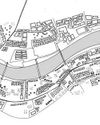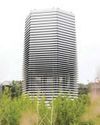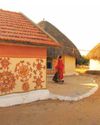At the mention of a Zaha Hadid-designed building, the most obvious imagery that comes to mind is larger-than-life, dramatic structures in a seemingly gravity-defying stance. In contrast, the calculated grandeur of the new Salerno Maritime Terminal by Zaha Hadid Architects (ZHA) exemplifies how classic elements we associate with ZHA’s past works continue to inform and inspire the design approach, while creating a structure that does not feel the need to restrict itself within these parameters.

As a species, human is perhaps obsessed with seeking patterns, analysing every detail to unearth an underlying connection to make sense of our world. Especially in contemporary times, the massive amount of sensory data we receive can be quite overwhelming. In such a complex scenario, we look for patterns as a basic, instinctive mechanism to understand, predict and navigate our surroundings. This process helps us adapt to rapid changes, and the unpredictable variables. Thus, in a sense, seeking patterns enhances our adaptiveness. One can argue, therefore, that our most primary adaptive advantage is, quite literally, our adaptiveness!
This pattern-seeking obsession also extends to architecture, and how we perceive work emerging from different practices. Perhaps as a means to recognise and connect an architect’s body of work over the years, we look for a signature style. But do architects consciously impose their ‘style’ on their works? Is continuing their style-trajectory a key consideration while designing? If so, then it is not a reductive, restrictive approach? While these questions are perhaps apt for a larger conversation in the architectural discourse, it is quite evident that as end-users, we are prone to trying to fit architectural works into ‘types’ and ‘styles’.
Take one of the most prominent, global practices in recent times, Zaha Hadid Architects, for instance. Over the years, they’ve produced fascinating works that that, in an almost unanimous public opinion, explore ‘fragmentation, flotation, and liberation from gravity’. And we quickly made the connection to words like new-age, outer space-inspired, larger-than-life, and dramatic to qualify ZHA works. But what does ZHA do with this sort of categorising?
This story is from the November 2017 edition of Indian Architect & Builder.
Start your 7-day Magzter GOLD free trial to access thousands of curated premium stories, and 8,500+ magazines and newspapers.
Already a subscriber ? Sign In
This story is from the November 2017 edition of Indian Architect & Builder.
Start your 7-day Magzter GOLD free trial to access thousands of curated premium stories, and 8,500+ magazines and newspapers.
Already a subscriber? Sign In

Interlacing Perspectives
‘Meraki-2019’ A visionary Seminar series presented by Dr.Baliram Hiray College of Architecture, Bandra(East), Mumbai.

Facilitating A Community Through Architectural Practice
The humble, self-designed, self-built and organically planned home built by the majority of the world population rarely gets appreciated and critiqued as a viable lesson in architectural design.

The Art Of Solving Problems Creatively
The practice of architecture is perhaps incomplete without the complement of a variety of other arts.

Upcycling towards a playful tomorrow
Play is like the middle child, often forgotten, and always taking a back seat. For young kids, play can simply be running around, armwrestling with friends, building sandcastles on the beach, or singing popular music tracks in the shower.

Balancing The Poetics And Pragmatism Of Everyday Design
Humanity is faced with an oxymoronic crisis. The crisis involves the earth, the environment, impending looms of climate change, deforestation, loss of species, dwindling resources etc.

Just Give Me Some Space: Discussions And Beyond
Just Give Me Some Space (JGMSS) is Suha Riyaz Khopatkar’s debut book that paints a portrait of the dynamic life of an architecture student.

The Next In Vernacular Architecture
Architecture has become a capitalist.

Rethinking The Future: Architecture And Its Education
“I want to be like animals, the bird makes a nest in one or two days, the rat digs a hole in a night, but intelligent humans like us spend 30 years to have a house, that’s wrong.” - Jon Jandai

Uniting The Human-Scale With The City-Scale
London-based architect Usman Haque is famed for his interactive architectural systems, and for his exploration of newer, more effective ways of creating human engagement and interaction through his designs. Indian Architect & Builder caught up with him, to quiz him on a variety of topics such as his journey as an architect, his inspirations and philosophies, architects using the digital revolution to their advantage, and more!

Framing spaces
Almost every architect also doubles as a photographer or at least an enthusiast.